This was published 1 year ago
‘How dare you do this’: How Defence’s river of poison put thousands of years of culture in jeopardy
Part two of the Poisoned Paradise investigation into contamination of water supplies around Wreck Bay from a Defence base reveals the shocking impact on local culture.
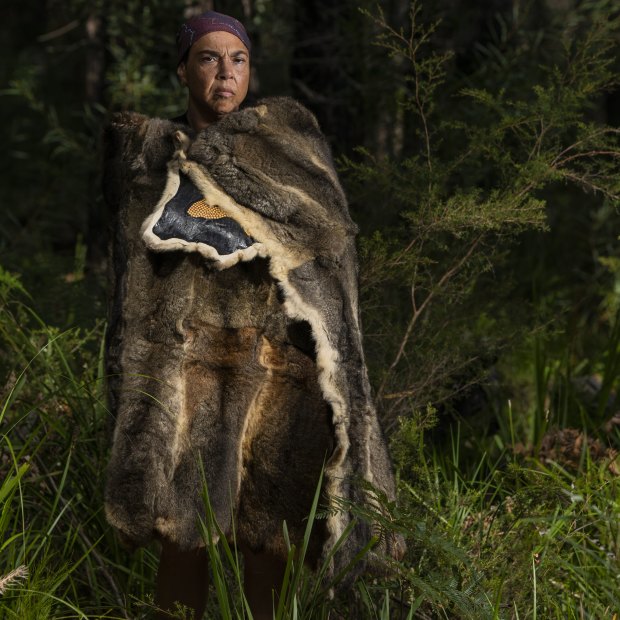
Artist and Wreck Bay resident Theresa Ardler.Credit: Rhett Wyman
Aboriginal and Torres Strait Islander readers are advised that this article contains the names and images of people who are deceased.
It’s one of Australia’s most spellbinding strips of coastline, where turquoise waters lap against sandstone cliffs and ribbons of white sand curl around unspoilt eucalypt forest.
Since word spread internationally that it harboured “the whitest sand on earth”, Jervis Bay has become a tourist mecca, attracting more than 1.4 million visitors a year.
But Aboriginal people have always known the beauty of this place. To the Koori kids growing up in the village of Wreck Bay, this was home, and it was perfect. Or so they thought.
“I was Moana in paradise,” laughs one of Wreck Bay’s elders, Aunty Vida Brown, when asked to describe her childhood in the village on Jervis Bay’s southern peninsula, 10 kilometres from the famous Hyams Beach.
With her 12 siblings, she spent her days swimming with stingrays, rock hopping along the beaches, shrieking with laughter as they leapt off sand dunes into the creeks. They devoured lobster, oysters and abalone fresh from the sea.
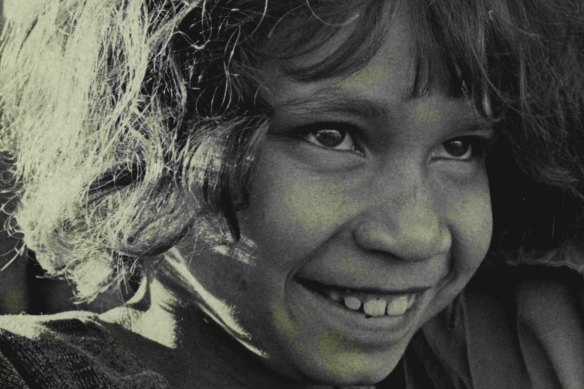
Vida Brown, then aged seven, at a cadet graduation ceremony at Wreck Bay in 1965.Credit: George Lipman
Occasionally, a grenade would wash up on the sand, collateral from the nearby Defence base. And after a day in the water, the children’s skin would erupt with painful sores and rashes: the first signs of trouble in little Vida’s paradise.
Sitting in a school hall half a century later, battling breast cancer and on dialysis for kidney disease, Aunty Vida finally learnt the ugly truth.
Wreck Bay was contaminated.
“I’ll never forget when the navy captain and their lawyers came out with their scientists,” she said. “I think it was just after I had my breasts taken off.
“‘I’m sitting here,’ I said, ‘not even properly healed, I’ve still got drains on me, draining all the poison out of me, you’re going to tell me that we’re living on land and drinking the water that’s going to be contaminated for 15,000 years?’
“I was so upset. I screamed at him.”
Defence had revealed at the 2017 meeting that firefighting foams used at its neighbouring Naval base had leached toxic per- and poly-fluoroalkyl (PFAS) chemicals – better known as “forever chemicals” – into Wreck Bay since the 1970s.
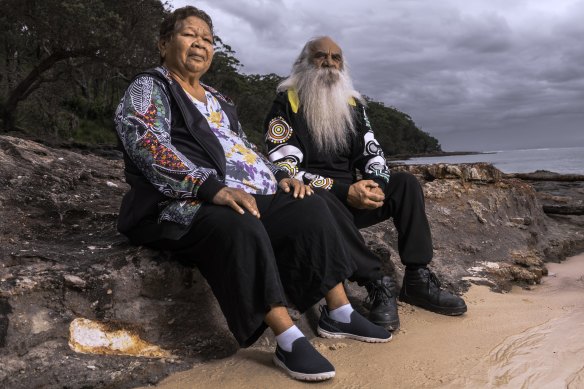
Aunty Vida Brown and Poppy Mac on the rocks at Wreck Bay.Credit: Rhett Wyman
The Sydney Morning Herald, The Age and a documentary film crew have spent two years chronicling how the chemicals that turned 3M into one of the most profitable companies on Wall Street have dealt a devastating blow to an ancient culture in one of the most secluded parts of the world.
Their invisible tentacles now have a stranglehold over Wreck Bay’s most sacred spiritual site, the waterways that once provided food and pristine drinking water, the plants used in bush medicine, even the clay once used in ceremonial practices and to nourish women during pregnancy.
“We was just absolutely blown away by it, to come into the community, to call a meeting and to make an announcement like that. With a carton of milk and a tin of coffee and some tea bags,” Aunty Vida recalled.
“How dare you do this?”
Firefighting foam has wreaked devastation for thousands of residents across Australia, but nowhere has it landed a crueller blow than at Wreck Bay, where the sacred spiritual connection to the land and waters has underpinned the community for millennia.
Now they must grapple with the unfathomable: the dark stain of contamination across the country they cherish, which breathes life into the village and is intrinsic to who they are.
“Everything you see comes from the land and it’ll go back to the land,” said Aunty Vida’s partner, Paul McLeod.
“Why do you want to kill the land, the mother that feeds you?”
The impact has led to a claim against the Defence Department over cultural loss that has reached a critical point for negotiations this week ahead of a trial slated to start next week.
Cultural ceremonies
Locals like Peggy Carter, who died in 2019 from breast cancer at the age of 39, would relish a trip to the clay pits on the fringe of the airstrip, a stone’s throw from where firefighting drills were carried out.
Kids would frolic in the pools of clay, smearing themselves with the pure ochre before ceremonial dance and using it as sunscreen or for rubbing on sores.
Aunty Vida said the pools contained “one of the purest clays on the planet”.
“It’s what they used to make medications out of,” she said.
“We used to eat it because we were lacking a lot of nutrition because we were given rations of food,” Aunty Vida recalled of her childhood in the late 1960s and early ’70s.
Women would sink their pregnant bellies into the cool waters, eating the clay to nourish their unborn babies with minerals and help their bones grow strong with calcium.
Defence contractors sampled water in the clay holes and found one of the PFAS chemicals at a maximum of .101 micrograms a litre, well beyond the safe drinking water limit of .07 micrograms a litre.
Country has meant everything to Wreck Bay artist Theresa Ardler, 51. She became the first Aboriginal education adviser to the Sydney Catholic Schools Office, has met the Pope in Rome to present him with the Uluru Statement from the Heart and has spoken about PFAS at the United Nations.
“We have a wealth of culture here,” Ardler said.
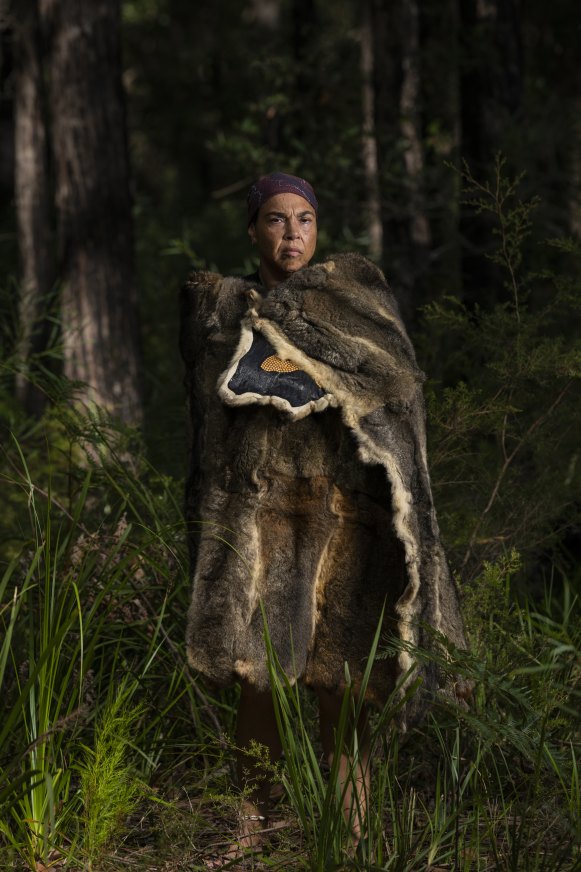
Artist and Wreck Bay resident Theresa Ardler.Credit: Rhett Wyman
“I come from a great line of storytellers and artists, and my nan was a master at shell work,” she said. “And so I finished my master’s and when I graduated I made a possum skin cloak, the first possum skin cloak made with a Sydney story on it since the early 1900s.”
River of poison
Named after a string of ships swallowed by the sea there during the 19th century, Wreck Bay was a deathtrap for vessels hugging the coastline too tightly on a stormy night.
Nonetheless, in 1911 the Royal Australian Navy deemed the peninsula an ideal location for its new naval college, HMAS Creswell.
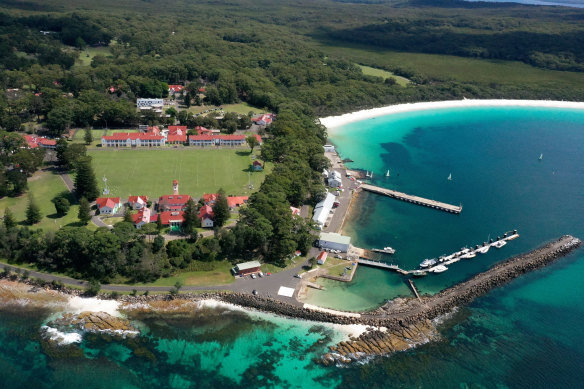
HMAS Creswell, home to the Royal Australian Naval College in Jervis Bay.Credit:
A firefighting training school and airstrip, together known as the Jervis Bay Range facility, were also constructed on a ridge overlooking the Wreck Bay village.
From the 1970s, naval recruits in their thousands were sent there for firefighting training with a state-of-the-art foam manufactured by 3M.
The key ingredient, PFAS – which didn’t degrade in the environment – doused the flames at record speed. The military had never seen a product like it.
A cocktail of dangerous substances, including aviation fuel, diesel, furnace oil and paint were set alight in pans before they were smothered in a white blanket of foam, a base employee said in Defence reports obtained by this masthead under freedom of information.
The river of poison disappeared out of sight as it drained into Mary Creek, which snaked downhill for two kilometres into the heart of Wreck Bay.
“Poor management practice had led to fuels being mobilised through the catchment of Mary Creek and led to the contamination of a number of areas,” the document said.
“The type of aviation fuel (aviation gasoline versus jet fuel) is not known.”
Downstream, tiny bodies were being immersed in the pollutants.
Mary Creek was a nursery for Wreck Bay’s infants to play in and learn to swim, before they were old enough to venture into the surf.
Unsuspecting parents thought it was the safest place for their youngsters.
They couldn’t have known poison lurked in the water: PFAS chemicals were colourless and odourless. The suds that would rise to the surface when the water churned in the rain were the only clue that something was wrong.
When Defence tested for PFAS in recent years it discovered the two most toxic of the chemicals in the creek at 6.6 micrograms a litre.
The concentrations were 94 times the safe level for drinking water and more than triple the safe limit for recreational waters, despite the time that has elapsed since the Commonwealth alleges it stopped using the toxic foam at the base, in 1997.
“Mary Creek, it’s probably the highest contaminated spot in the national park,” said James Williams, who helped spearhead a class action lawsuit against the Department of Defence that is due to go to trial next week.
“That runs down through a place called the falls, which is very sacred to us.
“As a kid I used to go up there and play a lot, swim under the falls and bathe in the water, drink the water from up there.”
For Uncle Nick Carter, no toxin could ever diminish the wild beauty of this place, where water cascades into pools of inky water, flanked by curtains of unspoilt bushland.
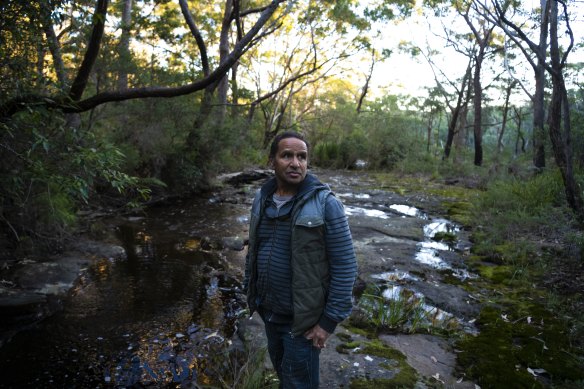
Uncle Nick Carter at a cultural site on Mary Creek, Wreck Bay.Credit: Rhett Wyman
“It’s a part of me, so who I am and where I belong. And I’ll always feel that about this place,” Uncle Carter said.
Now the community is forbidden from entering the Falls. Mary Creek contains such hazardous levels of chemicals that it has been completely closed to human use, and warning signs have been erected at nearby Summercloud Creek and Captains Lagoon.
It’s a running joke among locals that you need microscopic lenses to read the signs, which do not disclose the water is contaminated but say it is being “tested” for PFAS.
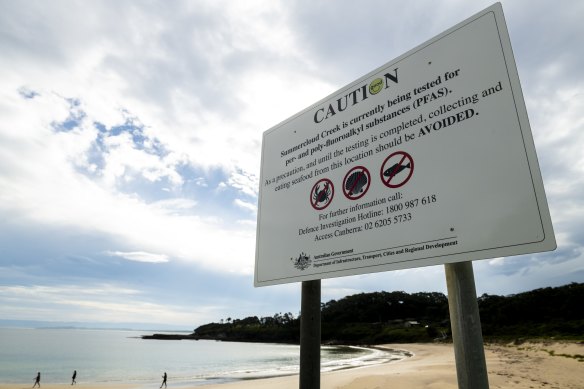
Contamination warning signs around Wreck Bay.Credit: Rhett Wyman
“If you didn’t trip over these signs, you wouldn’t even know what they said,” Williams said.
No change in the landscape escapes the notice of Carter, a softly spoken man who is regarded as one of the village’s most skilled fishermen and divers.
A carpet of kelp had vanished from the shallow waters around Wreck Bay over the past few decades and Carter believed the toxins may be to blame.
“Kelp provides a habitat for all sorts of creatures,” he said. “Removing it is like cutting down the trees.”
‘Bay of plenty’
On a grassy headland between two pristine beaches, near a world-famous surf break, these views would be worth millions.
But the smattering of about 50 fibro and brick homes that make up the Wreck Bay village are unassuming. Inside, each one tells a story. Photos of grandchildren, family heirlooms, shells and artworks bring the walls to life.
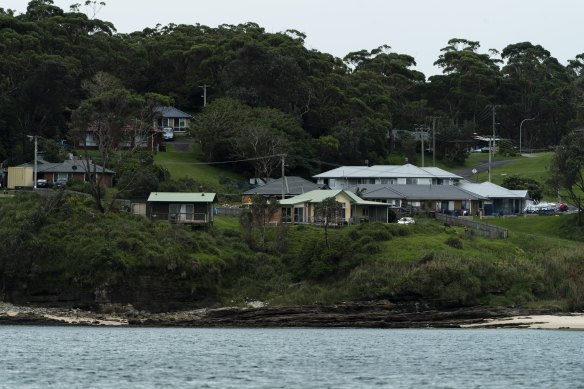
Homes at the Indigenous community of Wreck Bay on the NSW South Coast.Credit: Rhett Wyman
Shell middens reveal Aboriginal people have occupied this part of the coast for at least 20,000 years, according to documents held by the Australian National Archives. The first homes were fashioned out of timber that drifted ashore from the shipwrecks.
After colonisation, a white manager was installed to police daily life, but the Wreck Bay community thwarted several attempts to relocate the village.
The show of strength would become a running theme for a community that refused to let others run roughshod over their rights.
“I think it had a lot to do with our old people at first,” Aunty Vida said.
“They fought to be educated and then they passed that knowledge on to their children like us.”
A celebrated artist in her traditional name, Nardaparli, Aunty Vida’s painting of a stingray was chosen to feature at a historic land handback ceremony in 1987, when the Hawke government returned 403 hectares of land to the community.
“This is my politics,” Aunty Vida said of her artworks. These days the painting that once brought her so much joy is not so easy. Illness makes her once-strong arms throb and ache.
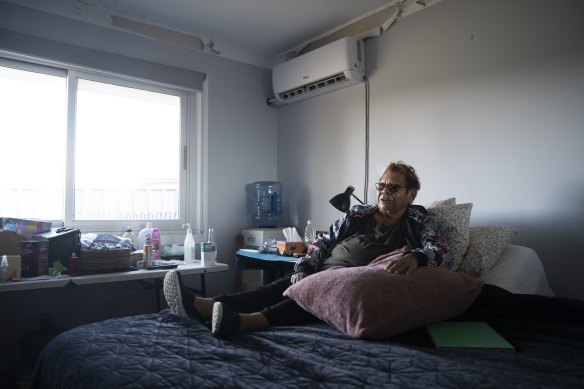
Wreck Bay resident Aunty Vida Brown.Credit: Rhett Wyman
A decade later, tears flowed as Aboriginal affairs minister Robert Tickner poured a handful of sand through community leader Phillip McLeod’s fingers, signifying the return of the surrounding national park to its traditional owners, in a leaseback deal modelled on Uluru and Kakadu national parks.
It was renamed Booderee, an Aboriginal word meaning “bay of plenty”.
Months after the ceremony, there was outcry as the navy resumed bombing exercises at Jervis Bay’s northern peninsula, an area regarded as sacred by Aboriginal people.
The episode highlighted the ongoing ambivalence in the community towards the navy’s presence. Some residents have fond memories of playing rugby league and socialising with base personnel in the officer’s mess.
Others have been angered by what they perceive as a blatant disregard for the community’s wishes.
“The relationship with the Defence is not real good,” said Rob Williams, one of many registered members of the Wreck Bay community who grew up in the village but have dispersed to neighbouring suburbs, mostly due to the lack of housing.
Growing up on in Wreck Bay, Williams would spend his days in the bushland, hoping to spy geebungs, with their fleshy melon-like fruit, or the plump, juicy leaves of a pig face.
Certain plants had antibacterial and anti-inflammatory properties that could heal the sick: this was knowledge cultivated and passed down to the young over thousands of years.
“They looked like a jelly bean, but they used to call them snot golden because when you squeeze them all the mucus would run out,” McLeod recalled.
“It was medicine.”
Now people in the community wonder if the plants that traditionally healed them contain poison.
“What is there to pass down now? We can’t show the kids where the bush food is no more because it’s all contaminated,” Aunty Vida said.
“I really do strongly believe in traditional healing methods, especially with cancer. But I can’t get bush medicine from around here, even though it’s growing thick everywhere.
“I put word out down the coast, any of you mob got medicine? Please, I need some.”
‘It’s just ruined everything, this PFAS’
The youngest in his clan, Rob Williams had the task of lighting the fire and retrieving fresh water from the springs around Wreck Bay for his family. Fresh seafood – bream, mullet, grouper, flathead and pippies – would be cooked and shared among families in the village, he recalled.
“It was the best diet you could have,” he said. “We were very rarely eating highly processed foods, like high in fat and sugars.”
Williams is overcome by grief at the thought he will not be able to teach his infant grandchildren culture in the same way that he taught his daughters.
“I don’t want to teach them anywhere else, it’s just not the same,” he said, fighting back tears.
“We need to do it where we live and die and get returned back to the earth.
“Even when you die, you only live as long as your memory. So, in five or six generations, if no one’s remembering you, that’s when you really die.”
But Williams is also fearful of what PFAS is doing to people’s bodies. His daughter has had a brain tumour, and he suffered a near miss himself when he needed emergency surgery on his heart at the age of 42.
He said no amount of compensation from the Commonwealth could ever atone for what the village has lost.
“Even if they gave me a million dollars … it’s worth nothing, isn’t it?
“It’s just ruined everything, this PFAS.”
‘Never be another Wreck Bay’
Adults have been advised not to eat any seafood from Mary Creek and to limit themselves to 15 serves of seafood a year at nearby Flat Rock Creek and Captains Lagoon. Restrictions are even more severe for children.
The community has been told fishing from the beach is safe, but many locals are hesitant to cast a line on beaches that receive runoff from contaminated creeks.
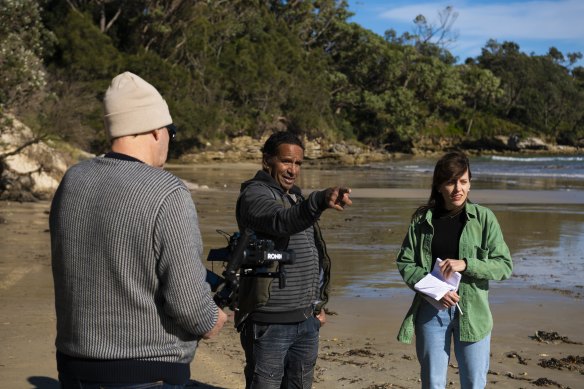
Uncle Nick Carter with Herald journalist Carrie Fellner, filming a scene for the upcoming Stan documentary on Wreck Bay.Credit: Rhett Wyman
Fishing has always been a bedrock in this village with many hungry mouths to feed – a means of survival, both physically and spiritually.
Mobs of fishermen would spend their days on the beach, scanning the water for the telltale brown shadow of a school of mullet.
Laughter rang out from daybreak until evening as the mates would jest and tease each other. These days, the shoreline has fallen quiet.
University of Wollongong emeritus Professor Paul Chandler, who has a long association with the community as a member of the Jervis Bay school board, has spent four years researching “the sad trail of cultural loss” in Wreck Bay due to PFAS.
Chandler said the community had shown resilience and humour in the face of great adversity.
“They suffer from blatant discrimination, reckless ambivalence from the navy, curiosity from tourists who have unfair expectations, wanting to see real Aboriginals,” he said.
“They struggle against so many things but come out laughing every time.
“There will never be another Wreck Bay.”
New water source
Lake Windermere supplies drinking water to the Wreck Bay village, the Defence base and the popular camping grounds across the Booderee National Park.
Traces of the most toxic in the forever chemical family, PFOS, has been found in Lake Windermere at .001 micrograms a litre, according to Defence reports.
That concentration is well above what the United States considers acceptable, after its EPA dramatically slashed the safe level for PFOS in drinking water last year to .00004 micrograms a litre, based on science showing it could cause negative health effects at levels “near zero”.
However, it is still within the safe limits set by Australian Drinking Water Guidelines.
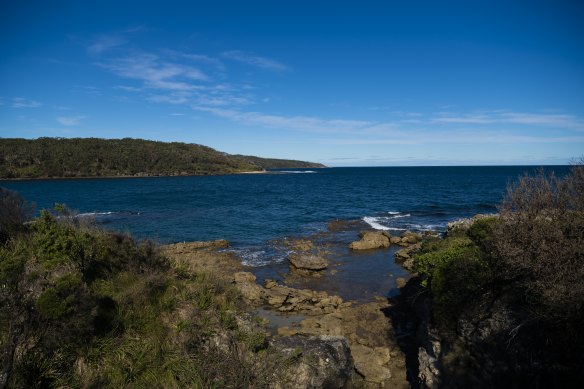
Wreck Bay.Credit: Rhett Wyman
Authorities recently announced they would spend $15.8 million to decommission the water supply from Lake Windermere and provide drinking water from an alternative source, but denied it was due to the contamination.
A spokesperson for the Department of Infrastructure said the health and safety of residents of the Jervis Bay Territory (JBT) and their confidence in the water supply was the Australian government’s first priority.
“Monthly testing continues to prove JBT drinking water is safe and PFAS levels in the drinking water remain many times lower than levels recommended by the Australian Drinking Water Guidelines,” the spokesperson said.
However, the spokesperson said it was necessary to connect the area to the neighbouring Shoalhaven water supply to increase “security and consistency” of the water supply.
They added that it would “remove the need to replace JBT’s existing water treatment infrastructure, which is nearing the end of its operational life due to the expense and difficulty of its maintenance”.
The number of naval officers residing on the base halved between 2016 and 2021, according to census data.
In a statement, the Department of Defence said: ”Defence remains committed to responding to per- and poly-fluoroalkyl substances (PFAS) contamination and will continue to remediate and manage PFAS contamination at all sites including Wreck Bay, while keeping local communities informed of progress.
“Wreck Bay is currently subject to a class action and as this matter is before the court, Defence cannot comment further.”
A 3M spokesperson said: “While PFAS can be safely made and used, 3M announced it will exit PFAS manufacturing and work to discontinue the use of PFAS across its product portfolio by the end of 2025.”
This investigation will feature in an upcoming Stan Original documentary by iKandy Films, directed by Katrina McGowan and produced by Janine Hosking, Katrina McGowan and Mat Cornwell and supported by Shark Island Foundation, Screen Australia and Screen NSW.
The Morning Edition newsletter is our guide to the day’s most important and interesting stories, analysis and insights. Sign up here.